Dominique Luchart's Blog, page 747
April 25, 2020
That’s the way the comet crumbles: Hubble image shows remains of Comet ATLAS
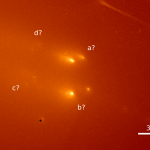
Skywatchers had high hopes that a comet called ATLAS would light up the night sky this spring, with forecasts suggesting it could become bright enough to see with the unaided eye.
Instead, the icy object crumbled to pieces — but it’s still putting on a spectacular show for scientists. Ye Quanzhi, an astronomer at the University of Maryland, snagged some time with NASA’s Hubble Space Telescope to take a look at Comet ATLAS on Monday (April 20) and caught a stunning image of its fragments that he shared on Twitter as a preview of his research.
“We have been following the break-up of ATLAS since it was first detected in early April, but with ground-based telescopes we couldn’t resolve most of the debris field,” Ye told Space.com in an email, adding that he was excited to see the new images. “With Hubble, we are finally able to resolve individual mini-comets.”
Related: The Hubble Space Telescope and 30 years that transformed our view of the universe
Ye hopes those mini-comets will help scientists understand what caused ATLAS to fall apart. In particular, astronomers rely on the distance between fragments to reconstruct events, since that distance increases as more time passes since a specific fracture.
Previous observations had identified four main fragments from Comet ATLAS. In the Hubble image, Ye said, he believes two of those fragments have broken down even more, yielding the two pairs of bright spots on the right, which represent the four largest fragments at the time.
The two clouds of brightness on the left may represent where older fragments have broken up into smaller pieces. Before beginning the observations, which lasted for one of Hubble’s orbits around Earth, Ye had hoped that Hubble would be able to spot more mini-comets in those regions, but it would appear those fragments had already disintegrated too far by the time the observations began.
Comet ATLAS is hardly the first icy space rock to break up within scientists’ view, but there are a few special conditions that make these new observations particularly exciting, Ye said. First, ATLAS happened to break up when it was quite close to Earth and quite bright, giving astronomers an especially clear view.
And ATLAS hails from the Oort Cloud, a distant sphere of icy rubble enveloping the solar system as much as 9.3 trillion miles (15 trillion kilometers) away from Earth. That vast distance makes it quite difficult for astronomers to study the Oort Cloud directly, but watching Comet ATLAS’s antics will help scientists develop new hypotheses about what’s happening out there.
ATLAS is only the second bright Oort cloud comet whose fragments Hubble has been able to observe in its 30 years of work, Ye said.
Email Meghan Bartels at mbartels@space.com or follow her @meghanbartels. Follow us on Twitter @Spacedotcom and on Facebook.
Join our Space Forums to keep talking space on the latest missions, night sky and more! And if you have a news tip, correction or comment, let us know at: community@space.com.
The post That’s the way the comet crumbles: Hubble image shows remains of Comet ATLAS appeared first on NEWDAWN Blog.
The top space stories of the week!

Hubble celebrates a generation of time in space, Starlink satellites launch again with new dimming measures expected soon, and NASA warns eager spaceflight watchers to stay away from Florida during an upcoming astronaut launch. All this, and more top stories this week from Space.com.
Hubble marks 30 years of amazing astronomy — and it keeps going
[image error]
(Image credit: NASA)The NASA-European Space Agency Hubble Space Telescope is still going strong after celebrating 30 years in space, and keeps shifting our perception of the universe. Its various discoveries include examples such as showing that the universe is accelerating, finding strong evidence of supermassive black holes in galaxy centers, and tracking changes in gas giant planets in the outer areas of the solar system. The telescope is still expected to do observations for many years, even though its last servicing visit by astronauts was more than 10 years ago.
Full story: The Hubble Space Telescope and 30 years that transformed our view of the universe
[image error]
(Image credit: SpaceX)NASA chief Jim Bridenstine asked space fans to stay away from the Titusville, Florida area (near Orlando) for the expected first launch of the Crew Dragon spacecraft in May, with astronauts on board. The concern is that the novel coronavirus could cause illness in any crowds gathering to watch the launch. Florida has not seen a launch of astronauts since the last space shuttle mission, STS-135, in 2011. Astronauts have been using facilities in Baikonur, Kazakhstan to reach the International Space Station.
Full story: NASA chief to space fans: Don’t travel to Florida to watch SpaceX’s 1st astronaut launch
[image error]
(Image credit: SpaceX)SpaceX’s bright Starlink broadband satellites will soon launch with a shade to greatly reduce the possible disruption to astronomy. The company plans to launch 12,000 satellites to low Earth orbit and has applied for permission to send 30,000 more into space. In recent months, various astronomical groups and astronomers have said Starlink could hurt scientific observations, as well as Native American cultures that use the night sky as part of their heritage.
Full story: SpaceX’s Starlink satellites will soon get glare-reducing ‘sunshades,’ Elon Musk says
[image error]
(Image credit: NASA/JPL-Caltech)Engineers at NASA’s Jet Propulsion Laboratory produced a prototype ventilator in just 37 days, in an effort to fight the novel coronavirus pandemic. The machine passed a key test this week at the Icahn School of Medicine at Mount Sinai in New York City. The agency is now petitioning the U.S. Food and Drug Administration for fast-track approval, as well as seeking private manufacturing partners.
Full story: NASA engineers build new COVID-19 ventilator in 37 days
Interstellar heist brought asteroids into our solar system
[image error]
(Image credit: NASA/NEAR Shoemaker)It looks like our solar system has several interstellar residents. New analysis of the orbits of Centaurs, which are asteroids that orbit the sun between Jupiter and Saturn, suggest they came from outside of our solar system early in the universe’s history. Stars were closer together, billions of years ago, and it was easier for them to snatch material from each other’s neighborhood.
Full story: Our solar system stole asteroids from interstellar space when it was young, scientists say
[image error]
(Image credit: SpaceX)Starlink, the broadband constellation of satellites from SpaceX, keeps getting bigger and more powerful with each launch. A Falcon 9 rocket hefted 60 more of the satellites into orbit as SpaceX eventually targets having at least 12,000 in orbit. The launch this week also saw the Falcon 9 landing safely back on Earth, allowing for use on some future mission.
Full story: SpaceX launches 60 Starlink satellites, aces rocket landing in milestone flight
Follow Elizabeth Howell on Twitter @howellspace . Follow us on Twitter @Spacedotcom and on Facebook .
[image error]
OFFER: Save at least 56% with our latest magazine deal!
All About Space magazine takes you on an awe-inspiring journey through our solar system and beyond, from the amazing technology and spacecraft that enables humanity to venture into orbit, to the complexities of space science.View Deal
Join our Space Forums to keep talking space on the latest missions, night sky and more! And if you have a news tip, correction or comment, let us know at: community@space.com.
The post The top space stories of the week! appeared first on NEWDAWN Blog.
Celebrating 30 years of the Hubble Space Telescope
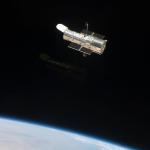
It’s been 30 years since NASA launched the Hubble Space Telescope on April 24, 1990. The observatory was carried aloft in the payload bay of space shuttle Discovery, and for three decades Hubble’s history was closely intertwined with the shuttle’s. The telescope was originally scheduled for launch in 1986, but the tragic Challenger accident at the start of that year led to a four-year delay.
When Hubble finally made it into orbit, it still wasn’t smooth sailing. Almost immediately, scientists discovered a serious flaw in the telescope’s mirror that made stars look slightly blurred, rather than like sharp pinpoints of light. Since the whole point of putting Hubble above the Earth’s atmosphere was to avoid the blurring that ground-based telescopes suffer from, this was disastrously bad news.
For any other astronomical satellite the situation would have been mission-ending, but not for Hubble, which was designed all along to be serviceable in space — another way its destiny was inextricably tied to the shuttle.
Related: The Hubble Space Telescope and 30 years that transformed our view of the universe
The first servicing flight, by space shuttle Endeavour in December 1993, was originally planned as a routine maintenance visit. Instead it became an urgent rescue mission. In a series of tense spacewalks, the astronauts replaced Hubble’s main camera with a redesigned one and installed a corrective optics package for the other instruments.
In what may be the second greatest feat of human spaceflight (after the moon landings), Hubble was brought back up to its design spec. Now it could see all the wonders of the universe with a clarity that could never be achieved from Earth’s surface. Four subsequent servicing missions, the last by space shuttle Atlantis in May 2009, have ensured Hubble remains the world’s most powerful telescope to this day.
As dark as the night sky looks from ground level, it never gets completely black due to airglow in the atmosphere, which limits the ability of earthbound astronomers to take long-exposure photographs. At Hubble’s high altitude, however, the background sky really is pitch black, which means it can see incredibly faint objects if it stares at the same patch of sky for long enough. That’s the rationale behind one of Hubble’s most impressive achievements: the series of ‘deep-field‘ images, of which the first was released in 1996 and the most recent — the Hubble Extreme Deep Field (HXDF) — in 2012.
“Before Hubble, we knew essentially nothing about galaxies in the first half of the life of the universe,” Garth Illingworth, one of the scientists behind the project, told All About Space. “That’s the first 7 billion years of the universe’s 13.8-billion-year life. Now Hubble, through remarkable surveys like HXDF, has probed into the era of the first galaxies.”
Through this type of work, Hubble has discovered galaxies like GN-z11, the most distant discovered by Hubble. “Just 400 million years after the Big Bang, Hubble is looking back through 97% of all time to see GN-z11, far outstripping what can be done with the biggest telescopes on the ground.”
Although Hubble is best known for the spectacular images taken with its cameras, these are complemented by other, equally important instruments in the form of spectrographs. The latter add a whole new dimension, Hubble’s senior project scientist Jennifer Wiseman said. “The spectrum taken with the STIS spectrograph on Hubble tells you about the composition of the gases and the material in the system, and the motions of the material as well. Having cameras and spectrographs gives you a very powerful combination of scientific tools.”
Perhaps the most dramatic use of Hubble’s spectrographs — and one that few astronomers would have envisioned when it was launched 30 years ago — is in exploring the atmospheres of recently discovered exoplanets around distant stars. “This technique called transmission spectroscopy has been leveraged about 100 times,” Nikole Lewis, an exoplanet specialist at Cornell University, told All About Space. “We can actually look at starlight filtered through those planet atmospheres to find out something about what’s in the air around these planets beyond our solar system.”
It’s particularly exciting to find traces of chemicals which, on Earth, we associate with life — water being the most obvious one. Hubble made headlines in 2019 with the first discovery of water in the atmosphere of an Earth-size exoplanet, K2-18b, which orbits in the habitable zone of a red dwarf star.
In its 30 years in space, the Hubble Space Telescope has contributed to every aspect of astronomy — from our own solar system to the most distant galaxies — and more than 15,000 scientific papers have been published detailing its results. These include many exciting new discoveries, including evidence of the supermassive black holes lurking in the centers of galaxies.
One Hubble scientist, Adam Riess of the Space Telescope Science Institute (STScI), which operates Hubble in partnership with NASA, was awarded a share of the 2011 Nobel Prize for his part in observations that the universe’s expansion is accelerating, suggesting the presence of mysterious dark energy.
[image error]
NASA astronaut Kathy Thornton accesses Hubble repair equipment during the first servicing mission, in 1993. (Image credit: NASA)As the senior project scientist for Hubble, it’s Jennifer Wiseman’s job to keep track of the full range of Hubble’s scientific activities in different areas of astronomy. “Thirty years into the mission, the scientific productivity of Hubble is at an all-time high,” she told All About Space. “The reason is that the servicing missions, especially the final one in 2009, have been very successful, keeping Hubble very fit for great observations and cutting-edge science. Clever new observing techniques developed by Hubble scientists have boosted new discoveries as well. And the outstanding expert operations team on the ground — engineers, technicians, managers and computer support — keep diligent watch over Hubble’s subsystems to keep science return at a maximum as Hubble ages.”
So what’s the payoff for the scientific community? “Currently there are almost a thousand science papers published every year based on data from Hubble,” Wiseman said. “That’s more than ever before. About half of these are based on data taken from the Hubble archive. This is fantastic. It means that data originally taken for one scientific purpose is being used again for a different scientific purpose — a great return on investment!”
Some of the scientists who work with Hubble today were still at school — or not even born — when it was launched 30 years ago, while others have been closely involved with it throughout that time. In the latter category is Colin Norman, a senior staff member at STScI who watched Hubble’s launch from Cape Canaveral, Florida, in April 1990.
“Hubble has changed the landscape of astronomy and astrophysics,” he said. “It has far exceeded its early goals — no other science facility has ever made such a range of fundamental discoveries. It’s been a privilege to be associated with this effort that has become embedded in the culture of our time.”
That last point is an interesting one. For all its groundbreaking scientific discoveries, Hubble’s most unique achievement is arguably the inspirational impact it’s had on the general public. It would be an understatement to say it’s the most famous telescope in history.
Before Hubble, people without a special interest in astronomy probably couldn’t have named a single telescope. Yet today ‘Hubble’ is a household name, instantly recognizable to people all over the world and a symbol of both the brilliance of human ingenuity and the wonders of the universe.
What’s the reason for Hubble’s uniquely iconic status? “It reads like a movie script; it has a story arc,” Ray Villard, STScI’s news director, said. “The anticipation of launch, the optical failure, redemption with the servicing missions — then more drama when it was cancelled in the last decade.”
Fortunately that cancellation was averted, and Hubble is still with us — hopefully for many years to come. As Villard says, “Well toward 2030 we’re back to doing some of the best science we think we can ever do with Hubble.”
This article was adapted from a previous version published in All About Space Bookazine, a Future Ltd. publication. Follow us on Twitter @Spacedotcom and on Facebook .
The post Celebrating 30 years of the Hubble Space Telescope appeared first on NEWDAWN Blog.
Dyson says the UK doesn’t need the ventilator it developed to treat COVID-19 patients
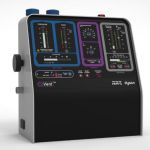
After spending about $25 million on the project, British technology company Dyson says the UK government doesn’t need the ventilator it developed to help treat COVID-19 patients, Reuters reported. The company, best known for its vacuum cleaners, said last month it had an order from the UK government for 10,000 of the breathing machines and developed one it called the CoVent.
Dyson was awaiting regulatory approval for the design of the CoVent, reportedly built in 10 days using the company’s existing motor technology. The bed-mounted, portable ventilator is able to run on battery power if necessary.
Ventilators are needed to treat critically ill COVID-19 patients, many of whom suffer from severe respiratory symptoms. Other companies– including GM, Ford, and Tesla–shifted to developing ventilators over the past several weeks as demand for the devices increased.
James Dyson, the company founder, said he did not regret the time and resources put into the ventilator effort. “Mercifully they are not required,” he said in a statement adding, “I have some hope that our ventilator may yet help the response in other countries, but that requires further time and investigation.”
The post Dyson says the UK doesn’t need the ventilator it developed to treat COVID-19 patients appeared first on NEWDAWN Blog.
Amazon restricted from selling non-essential items in France after it loses court appeal
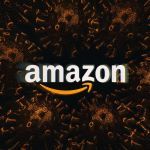
Amazon has lost its appeal of a French court ruling that requires the company to temporarily stop delivering nonessential items in France or face hefty fines, the New York Times reported.
The Versailles Court of Appeals upheld a lower-court ruling that led the e-commerce company to close six of its fulfillment centers in France and put workers on paid furlough. Amazon had said the definition of what goods it could ship was not clear and rather than risk being fined, opted to temporarily close the fulfillment centers.
Under the French court ruling, Amazon can only deliver items directly related to medical supplies, hygiene products, and food items in the country during the coronavirus pandemic. It must conduct a risk assessment of its warehouses with labor unions. The unions took Amazon to court for what they considered a failure by the company to protect warehouse employees from exposure to the coronavirus.
The company tweeted in response to the ruling, “We have heard the outcome of our appeal and remain puzzled by the decision. We are currently assessing the implications for our sites as well as for our employees and customers in France.”
Nous sommes en train d’en evaluer les implications pour nos sites ainsi que pour nos collaborateurs, pour les clients en France.
— AmazonNewsFR (@AmazonNewsFR)
The Versailles Court of Appeals said if Amazon violates the ruling the company would be fined EUR100,000 (about $108,000) for each delivery that does not meet its conditions. The court will revisit the company’s progress next month.
The post Amazon restricted from selling non-essential items in France after it loses court appeal appeared first on NEWDAWN Blog.
9 new trailers you should watch this week

With Parasite still on my mind, I decided to go back and rewatch Snowpiercer the other week since both Bong Joon-ho movies deal with such similar themes around class. Snowpiercer, obviously, does it in a much more action-packed way, but the big picture is very much the same: an upper class surviving off of a lower class, who slowly fight their way up.
The most fun thing about Snowpiercer is something I actually wish it did more of: building such brilliant, strange, self-contained worlds within each car. The ones that Bong focuses on feel so vibrant and full. You really get an understanding of who lives in each car and the culture they’ve created for it. But as the movie goes on, it rushes through so many of them, and I wish there was more time to linger.
What I think really holds Snowpiercer back, though, is the lack of a main character. Sure, we have Chris Evans leading us through the film… but who is he? What does he want? Why should we care? He has no traits other than being a leader — at least until near the end of the film, when he’s given a lengthy monologue about his past that, in a worse movie, would be famous for how laughably bad it is. The character works well enough to get us to the front of the train, but not enough to connect us to the film’s message in the way that the family members in Parasite do.
Check out nine trailers from this week below.
Snowpiercer
TNT has been very slowly putting out new looks at its TV adaptation of Snowpiercer. It looks good! It seems like the show is sticking very close to the film adaptation so far, though, and I’d really like to see what else it has to offer. It premieres May 17th. (P.S. I swear I’d planned to write about the film before I saw this!)
Hollywood
Netflix has a new limited series coming up that fictionalizes the early days of Hollywood. It’s from Ryan Murphy, which means it’s filled with bright colors, beautiful people, and lots of style. The show seems to pay particular attention to LGBTQ actors and people of color, which could let it tell a more interesting story than the many other films and shows that have mined this era of moviemaking. It comes out May 1st.
Love Life
With roughly a month to go before the service launches, AT&T is starting to give us a first look at HBO Max’s debut series. It’s going to be interesting to see how they compare to the typical HBO fare. From this first look, it seems like Love Life — which stars Anna Kendrick and is executive produced by Paul Feig — shares HBO’s typical high production quality, but it comes with maybe a little more wide audience appeal than, say, Girls or Euphoria. The show debuts May 27th, alongside HBO Max.
I May Destroy You
For comparison, here’s what a real HBO series looks like. I May Destroy You is a new series created by and starring Michaela Coel about a celebrated writer dealing with the aftermath of sexual assault. It looks stylized and personal in a way that Love Life just does not. It debuts some time in June.
All Day and A Night
Netflix has a new feature from Black Panther co-writer Joe Robert Cole. The film looks beautifully shot and has appearances from Jeffrey Wright and Yahya Abdul-Mateen II. It comes out May 1st.
Jerry Seinfeld: 23 Hours to Kill
I don’t usually post stand-up trailers, but this is a big one: Netflix has Jerry Seinfeld’s first stand-up special in 22 years. How’d Netflix nab it? My guess is that it probably has something to do with Netflix buying the rights to Seinfeld next year. The special comes out May 5th.
Quiz
AMC has a new miniseries coming up about a scheme to cheat Who Wants To Be A Millionaire? and win the top prize. The series stars Matthew Macfadyen and is based on real events in 2001 that led to a conviction. The series debuts May 31st.
The Great
Hulu has a new look at The Great out this week. It basically looks like “The Favourite the TV show,” and I am very ready for that. It debuts May 15th.
We Are Little Zombies
I don’t know, man.
The post 9 new trailers you should watch this week appeared first on NEWDAWN Blog.
April 23, 2020
Amazon reportedly accessed third-party seller data to develop private-label products

Amazon employees have accessed sales data from independent Marketplace sellers to help the company develop competing private-label products, according to a report from The Wall Street Journal.
Past Amazon employees and one current one told the WSJ that rules barring the practice weren’t uniformly enforced. In addition, former Amazon employees said using the sales data from sellers was “a common practice that was discussed openly in meetings they attended,” according to the report.
One former employee told the WSJ they knew they were violating the policies:
“We knew we shouldn’t,” said one former employee who accessed the data and described a pattern of using it to launch and benefit Amazon products. “But at the same time, we are making Amazon branded products, and we want them to sell.”
In a statement to The Verge, Amazon disputed claims that the company has used private seller data to help develop its own products.
“Like other retailers, we look at sales and store data to provide our customers with the best possible experience,” Amazon said. “However, we strictly prohibit our employees from using non-public, seller-specific data to determine which private label products to launch. While we don’t believe these claims are accurate, we take these allegations very seriously and have launched an internal investigation.”
Amazon had previously testified to Congress that it doesn’t access sales data from sellers to make its private brands. “Our incentive is to help the seller succeed because we rely on them,” said Nate Sutton, Amazon’s associate general counsel, at a July 16th hearing. “They have many options. So we apply the same criteria to both and we do not use their individual data when we’re making decisions to launch private brands.”
Amazon has been under scrutiny for its anti-competitive practices for some time, though the Federal Trade Commission hasn’t yet opened a formal investigation into the company on the matter. The FTC has made preliminary inquires into Amazon’s deal with Apple to let Apple sell its products on the e-commerce site. FTC investigators have also interviewed Marketplace sellers about how much of their sales come from Amazon, Bloomberg reported last September. In February, a coalition of unions petitioned the FTC to investigate Amazon for anti-competitive practices, including its use of Marketplace data.
The post Amazon reportedly accessed third-party seller data to develop private-label products appeared first on NEWDAWN Blog.
The auto industry’s fight with the FCC over ‘vehicle-to-everything’ communication is heating up
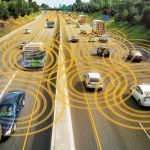
The auto industry is promising to dramatically expand “vehicle-to-everything” communication technology, but only if the Federal Communication Commission rolls back its decision to take away the current airwaves dedicated to that technology.
Vehicle-to-everything (V2X) technology is expected to increase road safety by allowing vehicles to communicate with one another, as well as smart infrastructure like traffic signals, to better avoid crashes or other mishaps. The Alliance for Automotive Innovation, a trade group that represents all of the major automakers and their suppliers, released a statement Thursday vowing to install 5 million pieces of V2X equipment over the next five years. But that promise was predicated on the FCC reversing an earlier decision to repurpose the airwaves that have been set aside for V2X communication.
“This commitment represents more than 50 times the number of devices on the road today,” said John Bozzella, the group’s president, in a statement. “This commitment by automakers clearly shows that these lifesaving technologies are ready and can be deployed in significant numbers in the next five years.”
In 1999, the FCC agreed to set aside 75 megahertz of spectrum in the 5.9 gigahertz band for something called Dedicated Short Range Communications (DSRC) services, which would be used to improve road safety through V2X technologies. Broadly speaking, V2X allows vehicles to send and receive messages about road conditions, like speeding cars, weather, or traffic congestion. It could also help prevent crashes by using that information to make decisions, like applying emergency braking.
Some experts say the wide deployment of the technology could help speed the adoption of self-driving cars, which could use vehicle-to-vehicle (V2V) communications to bolster their ability to “see” their environment and make better driving decisions.
But the auto industry was slow to develop V2X technology, and the rollout has been piecemeal. Mercedes installed V2V equipment in both the 2017 E-Class and 2018 S-Class. General Motors also introduced V2V in the Cadillac CTS in 2017. Other automakers began looking closely at a newer technology called cellular V2X (C-V2X), using existing cell networks to send communications.
In 2017, the Trump administration announced that it was killing an Obama-era mandate that would have required new cars to be equipped with V2V technology. And last year, tensions escalated when the FCC put out a new plan to use some of the spectrum set aside for V2X to expand Wi-Fi instead. Calling V2X “a promise unfulfilled,” FCC Chairman Ajit Pai proposed to make the lower 45MHz of the band available for unlicensed uses such as Wi-Fi and allocate the upper 20MHz for C-V2X.
Automakers lobbied against the decision, arguing that allowing Wi-Fi to use parts of the spectrum would interfere with connected car technology. Now the industry is vowing to increase its deployment of V2X technology, but only if the FCC walks back its decision to reallocate portions of the spectrum.
In a statement, the FCC said the auto industry’s promises were in effect too little too late. “Given that about 17 million new vehicles have been sold in the United States in each of the last five years, this is not an impressive commitment,” an FCC spokesperson said in an email. “Instead, it only reinforces the need for the FCC to reform the use of the 5.9 GHz band so that it is put to its best use for the American people.”
The post The auto industry’s fight with the FCC over ‘vehicle-to-everything’ communication is heating up appeared first on NEWDAWN Blog.
A fake Joe Biden ad is being amplified on Twitter by Trump campaign staffers
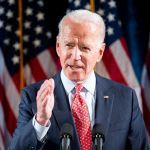
Over the last few days, a fake Joe Biden campaign ad has gone viral across Twitter, boosted in part by current and former Trump campaign staffers.
The image shows Biden with a beam of light emanating from his chest with “His brain? No. His heart.” overlaid on top with the campaign’s official logo, too. This tweet appears to be the original and has accrued over 10,000 retweets and 62,000 likes as of publication.
The fake ad has also been posted across other social media platforms like Reddit and Tumblr but caught fire on Twitter this week after an account called @khakijorts posted the image, captioning it, “This is a real ad 100% cannot make this up.”
The Biden campaign confirmed to The Verge that the ad was faked.
Tim Murtaugh, communications director for President Trump’s reelection campaign, has also tweeted out the fake ad. “Is this fake?” Murtaugh wrote. “Can’t trust Twitter, but this would seem to be the Biden campaign leaning in on the fact that ol’ Joe has lost his fastball.” Karen Giorno, former chief strategist for the Florida branch of Trump’s 2016 campaign, also shared the fake ad, writing “No joke. This is a real ad approved by @JoeBiden for President.”
Over the past year, Twitter has implemented a “manipulated media” tag to limit the spread of misleading political media, but it’s largely been targeted at “deepfake” audio and video, and it’s unclear whether the Biden image would count. In March, Twitter applied a “manipulated media” tag to a tweet featuring a doctored video of Biden that was shared by Dan Scavino, the White House’s social media director.
Bill Russo, deputy communications director for the Biden campaign, told The Verge, “While the President continues to assail our free press as ‘fake news’ — once again it is his campaign spreading lies and disinformation. Sadly, we don’t expect any better from the Trump Campaign as they get increasingly desperate.”
The ad has spread entirely organically, and neither side would have been able to boost it, since Twitter banned political advertising outright in October.
Throughout the 2016 campaign, Trump confidants like former New York City mayor Rudy Giuliani pushed a conspiracy theory that Hillary Clinton was suffering from a secret illness due to a brief absence from the campaign trail. Clinton was suffering from only mild pneumonia, but many believed her response to the rumors eroded her credibility. Right-wing groups have continued the tactic in 2020, posting similar health conspiracies regarding Biden throughout campaign season.
Twitter did not immediately respond to a request for comment, but as of press time, the platform has not labeled the image as false or taken down any of the tweets sharing it.
Updated 4/23/20 at 4:56PM ET: Included a statement from the Biden campaign.
The post A fake Joe Biden ad is being amplified on Twitter by Trump campaign staffers appeared first on NEWDAWN Blog.
April 22, 2020
Joe Biden looks to shore up climate credentials for Earth Day
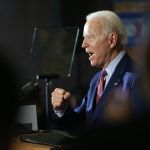
Joe Biden won key environmental endorsements this week as the 50th anniversary of Earth Day focuses attention on climate change. Longtime proponents of climate action Al Gore and Jay Inslee announced today that Biden has their endorsement. The League of Conservation Voters endorsed Biden on April 20th, potentially unlocking tens of millions of dollars in funding if the group continues the big spending it’s put into previous elections. And more than 80 prominent scientists penned an open letter giving Biden their backing ahead of Earth Day. It’s a major show of institutional support for Biden, but it remains to be seen whether these endorsements will help Biden win over voters concerned about climate change, who have emerged as a key priority in the Democratic primary race.
Much of that concern comes down to policies Biden has already announced. The candidate’s climate plan would bring the US to a “100 percent clean energy economy” and bottom out planet-heating greenhouse gas emissions by 2050. But progressive climate activists worry that the presumptive nominee doesn’t go far enough in phasing out fossil fuel extraction — in particular, failing to endorse a complete drilling and mining ban for federal lands and waters. He’s only gone so far as to say that he’ll stop new oil and gas permits and hasn’t outlined how he would phase out existing extraction or fracking. Without those moves, Biden’s campaign will continue to draw ire from young, green progressives.
Biden’s broad 2050 target falls in line with the recommendations of a leading authority on climate science, the United Nations Intergovernmental Panel on Climate Change, for which several of the scientists recently endorsing Biden have authored reports.
“Vice President Biden has long trusted the scientific consensus on climate change,” the scientists’ letter reads. “We are confident that, unlike President Trump, Joe Biden will respect, collaborate with, and listen to leaders in the scientific community and public health experts to confront the existential climate crisis and other environmental threats,” it continues.
But while progressive groups share the goal of zeroing out emissions by 2050, they’re not convinced Biden’s plan lays out enough money to get there. In his campaign documents, Biden pledges to spend $1.7 trillion on climate action over 10 years, quite a bit less than the $16.3 trillion pledged by his rival Senator Bernie Sanders (I-VT). For many climate activists, it’s a troubling shortfall that suggests the candidate doesn’t appreciate the severity of the challenge.
“Our goal is to turn out our generation to defeat Donald Trump, and as it stands right now it’s going to be significantly harder for us to do that. Unless Joe Biden really shows young people that he’s ready to fight for us, then our job is going to get harder,” Stephen O’Hanlon, a spokesperson for the Sunrise Movement, a group that’s been a driving force behind the push for a Green New Deal, told The Verge this month.
Biden has signaled that he might expand his climate plan moving forward. “I have asked my campaign to commence a process to meaningfully engage with more voices from the climate movement — including environmental justice leaders and worker organizations, and collaborate on additional policies in areas ranging from environmental justice to new, concrete goals we can achieve within a decade, to more investments in a clean energy economy,” Biden said in a statement after winning the League of Conservation Voters endorsement. He also announced that he and Sanders will work together on a task force on climate change.
But some young environmental activists aren’t holding their breath for a dramatic transformation from the presumptive Democratic nominee. “For anyone waiting with bated breath, we will not endorse @JoeBiden,” the El Paso chapter of Sunrise Movement tweeted on April 13th.
The post Joe Biden looks to shore up climate credentials for Earth Day appeared first on NEWDAWN Blog.



